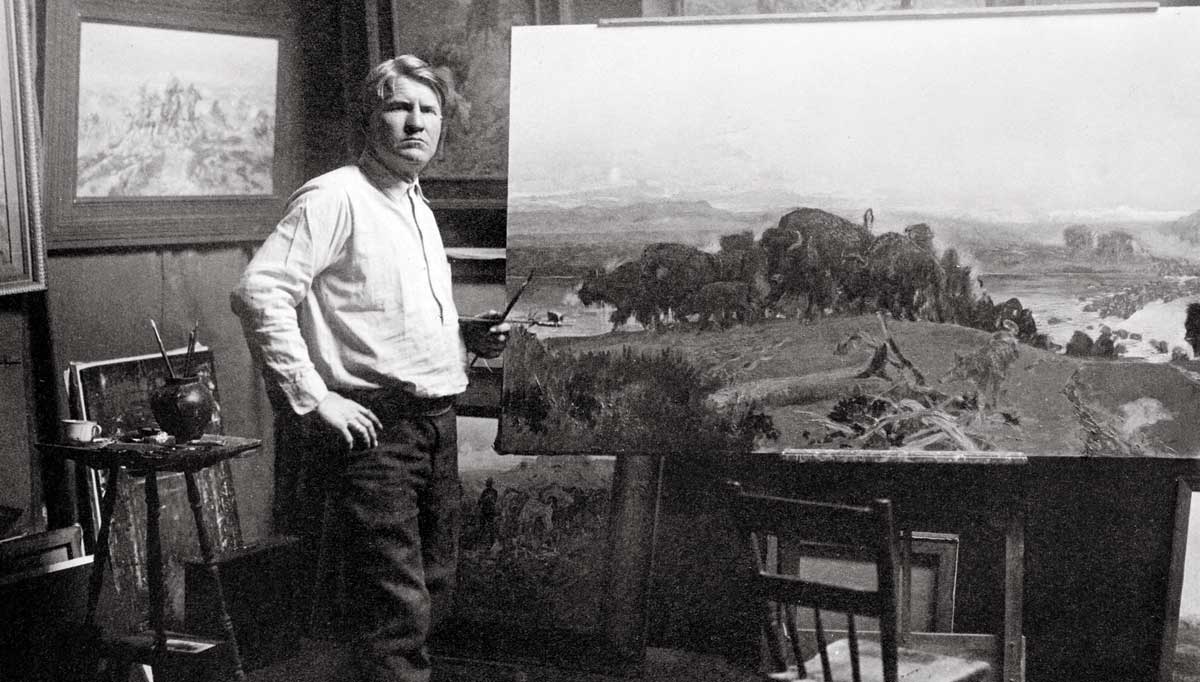- Editorial Offices
- 325 Brantly Hall
- Missoula, MT 59812
- (406) 243-2488
- themontanan@umontana.edu
- Icons By Maria Maldonado
New MontanaPBS documentary explores icon of the American West

By Courtney Brockman ’17
A band of Native Americans rides across a wall in Montana’s House of Representatives chamber in Helena in a painting done by the man known as the “Patron Saint of Montana.”
This artist, chosen to represent Montana in National Statuary Hall in Washington, D.C., is now the subject of a documentary years in the making by MontanaPBS – “Charles M. Russell and the American West.”
With co-producer and director Gus Chambers initially coming up with the idea in 2012 and the documentary set to air this year in a three-hour, three-part series at 8 p.m. Nov. 13-15, the first full-length documentary on Russell’s life has been a long ride to completion.
Through telling the story of Russell’s life, Chambers, co-producer and writer Paul Zalis and executive producer William Marcus hope to tell the story of the American West.
“Russell’s fingerprint is all over American Western culture,” Zalis says. “Montanans are Montanans in some ways because Charlie Russell helped remember who we all were a hundred-plus years ago.”
Growing up a cowboy, Russell knew how to paint a more accurate picture of the American West later used for film and television. A “common man’s artist,” he produced 4,000 pieces of artwork featured on items from calendars to cigar boxes.
“I grew up in Wibaux, and I’d sit in the barbershop in Wibaux, getting my hair cut,” Marcus says. “And all around the top of the barbershop were old calendars with Russell prints.”
For the documentary, MontanaPBS pieced together Russell’s life through his artwork and illustrated letters and spoke to everyone from biographers, historians and museum directors to a Hollywood scriptwriter and New Mexican cowboy. Voices for the documentary come from a host of actors, including UM alumnus and Academy Award-winner J.K. Simmons ’78 as the narrator.
“We did not want this to be too scholarly,” Chambers says. “So, for every scholar, we had an everyman – someone connected to the Russell world, but who hadn’t spent their life studying it in a mausoleum.”
Russell’s motivation for creating his artwork was far from monetary or a desire for fame. His wife, Nancy, a businesswoman, turned him into a national icon by bringing his artwork to the world.
Completely self-taught, Russell only spent three days in art school before dropping out. He had an enormous natural talent and a memory of landscapes and the people on it. He never painted on location.
“The guy had this photographic memory, so he could just spend a short time with anyone, and somehow it just stayed in his head,” Chambers says.
Perhaps the most fascinating element in Russell’s paintings is his representation of Native Americans. Often from their perspectives, his paintings featured Native Americans in the foreground as a part of the natural landscape, larger than whatever was on the horizon – whether it was a train, steamboat or explorers.
A fun personality, Russell also was known for dedication to his friends, especially the cowboys from the plains he stayed in contact with his whole life.
“To him, friendship was the most important thing in life,” Zalis says. “And I think that speaks to Montanans, too – just friendship, community, our sense of history – I think that’s what Charlie’s speaking to.”